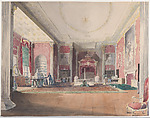The State Bed Chamber, Stowe Buckinghamshire
Joseph Nash British
Not on view
This drawing preserves a lost interior at one of England’s grandest 18th century country houses built by Richard Grenville, 2nd Earl Temple (1711-1779) and his successor George Greville, Marquis of Buckingham (1753-1813). Completed in the 18th century, the lavish interiors survived only until 1848, when the overspending of the 1st and 2nd dukes of Buckingham, forced a sale of the contents. Joseph Nash sketched what was known as the State Bed Chamber around 1838. In 1848 the elaborate four-poster bed was moved to a room at the other end of the house to accommodate a visit by Queen Victoria and Prince Albert, and the room was renamed the Duchess’s Drawing Room. Part of Stowe School today, it is known as the Garter Room after the star emblem at the center of the ceiling.
Christie's 1848 catalogue for the Stowe sale describes objects seen in the drawing such as nos. 230-31: "Two cabinets of oriental japan lacquer, with folding doors, shelves and drawers, and sliding fronts on carved and gilt stands." No. 243: "A pair of high-back Venetian armchairs, carved and gift, the seats covered with crimson velvet." Nos. 294-95: "A toilet table of silver and toilet glass in silver frame to correspond....presented by George Villiers, Duke of Buckingham, to the Countess of Shrewsbury at Avington...now the Countess of Jersey."
A 1797 description of the State Bed Chamber notes that the bed, marble mantle and ceiling were designed by Giovanni Battista Borra (Italian, 1713-1770) and the picture over the mantle is "a magnificent copy by Sir Godrey Kneller, of the famous picture of Charles I attended by Monsieur St. Simon, painted by Vandye and now at Hampton Court."
Due to rights restrictions, this image cannot be enlarged, viewed at full screen, or downloaded.


